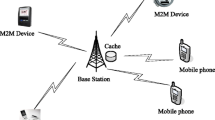Abstract
To reduce network access latency, network traffic volume and server load, caching capacity has been proposed as a component of evolved Node B (eNodeB) in the ratio access network (RAN). These eNodeB caches reduce transport energy consumption but lead to additional energy cost by equipping every eNodeB with caching capacity. Existing researches focus on how to minimize total energy consumption, but often ignore the trade-off between energy efficiency and end user quality of experience, which may lead to undesired network performance degradation. In this paper, for the first time, we build an energy model to formulate the problem of minimizing total energy consumption at eNodeB caches by taking a trade-off between energy efficiency and end user quality of experience. Through coordinating all the eNodeB caches in the same RAN, the proposed model can take a good balance between caching energy and transport energy consumption while also guarantee end user quality of experience. The experimental results demonstrate the effectiveness of the proposed model. Compared with the existing works, our proposal significantly reduces the energy consumption by approximately 17% while keeps superior end user quality of experience performance.
Similar content being viewed by others
References
PANIGRAHI B, SHAILENDRA S, RATH H K, et al. Universal caching model andMarkov-based cache analysis for information centric networks [J]. Photonic Network Communications, 2015, 30(3): 428–438.
CISCO. Cisco visual networking index forecast and methodology, 2015–2020 [M]. San Jose, CA, USA: CISCO, 2016: 1–22.
MOHAMMAD A, ALEXANDER L, AMIN V. A scalable, commodity data center network architecture [C]//Proceedings of the ACM SIGCOMM 2008 Conference on Data Communication. Seattle, WA, USA: ACM, 2008: 63–74.
LEE U, RIMAC I, HILT V. Greening the internet with content-centric networking [C]//The 1st International Conference on Energy-Efficient Computing and Networking. Passau, Germany: ACM, 2010: 179–182.
SU A J, CHOFFNES D R, KUZMANOVIC A, et al. Drafting behind akamai (travelocity-based detouring) [C]//Proceedings of the 2006 Conference on Applications, Technologies, Architectures, and Protocols for Computer Communications. Pisa, Italy: ACM, 2006: 435–446.
LEONARD W J. Tslp: Finally in the limelight [J]. Nature Immunology, 2002, 3(7): 605–607.
BARROSO L A, HOLZLE U. The case for energyproportional computing [J]. Computer, 2007, 40(12): 33–37.
LAOUTARIS N, SYNTILA S, STAVRAKAKIS I. Meta algorithms for hierarchical web caches [C]//Proceedings of the 23th International Conference on Performance, Computing, and Communications Committee. Phoenix, Arizona, USA: IEEE, 2004: 445–452.
CHEN C, BARRERA D, PERRIG A. Modeling dataplane power consumption of future internet architectures [C]//IEEE 2nd International Conference on Collaboration and Internet Computing. Pittsburgh, USA: IEEE, 2016: 149–158.
BOLLA R, BRUSCHI R, CARREGA A, et al. Cutting the energy bills of internet service providers and telecoms through power management: An impact analysis [J]. Computer Networks, 2012, 56(10): 2320–2342.
MAO Y, ZHANG J, LETAIEF K B. Dynamic computation offloading for mobile-edge computing with energy harvesting devices [J]. IEEE Journal on Selected Areas in Communications, 2016, 34(12): 3590–3605.
NEDEVSCHI S, POPA L, IANNACCONE G, et al. Reducing network energy consumption via sleeping and rate-adaptation [C]//Proceedings of the 5th USENIX Symposium on Networked Systems Design and Implementation. [s.l.]: USENIX Association, 2008: 323–336.
WANG K, YU J, YU Y, et al. A survey on energy internet: Architecture, approach, and emerging technologies [J]. IEEE System Journal, 2017, PP(99): 1–14.
SEETHARAM A, SOMASUNDARAM M, TOWSLEY D, et al. Shipping to streaming: Is this shift green? [C]//Proceedings of the First ACM SIGCOMM Workshop on Green Networking. New Delhi, India: ACM, 2010: 61–68.
BRAUN T, TRINH T A. Energy efficiency issues in information-centric networking [J]. Energy Efficiency in Large Scale Distributed Systems, 2013, 8046: 271–278.
LAFOND S, TRINH T A. Energy efficient thresholds for cached content in content centric networking [C]//Proceedings of the 24th Tyrrhenian International Workshop on Digital Communications-Green ICT. Genoa, Italy: IEEE, 2013: 1–6.
CHEN J, ZHANG H, ZHOU H, et al. Optimizing content routers deployment in large-scale information centric core-edge separation internet [J]. International Journal of Communication Systems, 2014, 27(5): 794–810.
YANG C, YAO Y, CHEN Z, et al. Video analysis on cache-enabled wireless heterogeneous networks [J]. IEEE Transactions on Wireless Communications, 2016, 15(1): 131–145.
CHOI N, GUAN K, KILPER D C, et al. In-network caching effect on optimal energy consumption in content-centric networking [C]//Proceedings of International Conference on Communication (ICC). Ottawa, Canada: IEEE, 2012: 2889–2894.
HELD M, WOLF P, CROWDER P H. Validation of subgradient optimization [J]. Mathmatical Programming, 1974, 6(1): 62–88.
KELLERER H, PFERSCHY U, PISINGER D. Introduction to NP-completeness of knapsack problems [M]. New York: Springer-Verlag, 2003: 483–493.
XU Y M, LI Y, WANG Z H, et al. Coordinated caching model for minimizing energy consumption in radio access network [C]//Proceedings of International Conference on Communication (ICC). Sydney, Australia: IEEE, 2014: 2406–2411.
MAVROTAS G. Effective implementation of the constraint method in multi-objective mathematical programming problems [J]. Applied Mathematics and Computation, 2009, 213(2): 455–465.
Author information
Authors and Affiliations
Corresponding author
Additional information
Foundation item: the National Natural Science Foundation of China (No. 61502038), and the Fundamental Research Funds for the Central Universities of China (No. 023600-500110002)
Rights and permissions
About this article
Cite this article
Xu, Y., Wang, Z., Li, Y. et al. Trade-off in optimizing energy consumption and end user quality of experience in radio access network. J. Shanghai Jiaotong Univ. (Sci.) 22, 742–751 (2017). https://doi.org/10.1007/s12204-017-1895-4
Received:
Published:
Issue Date:
DOI: https://doi.org/10.1007/s12204-017-1895-4




